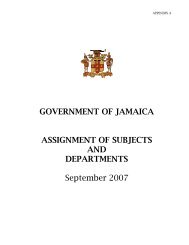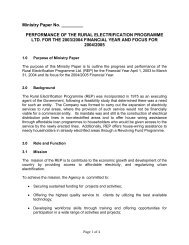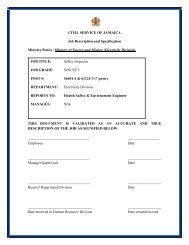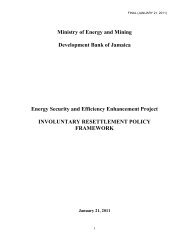Jamaica Biofuels Report - Ministry of Energy
Jamaica Biofuels Report - Ministry of Energy
Jamaica Biofuels Report - Ministry of Energy
You also want an ePaper? Increase the reach of your titles
YUMPU automatically turns print PDFs into web optimized ePapers that Google loves.
are produced and stored for later processing, ethanol operations will have to coincide withcane operations, which in <strong>Jamaica</strong> means about 250 days a year during the January-Juneperiod. During <strong>of</strong>f-season maintenance and repairs will be performed throughout the plant. Itshould be noted that the dehydration section <strong>of</strong> the plant can be available during <strong>of</strong>f-season forproduction <strong>of</strong> anhydrous ethanol from imported hydrous ethanol, if the economics <strong>of</strong> gasolinevs. ethanol make dehydration pr<strong>of</strong>itable.Oil-seed Crop ProcessingIn the absence <strong>of</strong> commercial oil-seed crops in <strong>Jamaica</strong>, large plots <strong>of</strong> land will have to bededicated to cultivation <strong>of</strong> plants, like castor beans, to support a biodiesel industry. Just likethe sugarcane-to-ethanol operation, the crop-to-biodiesel process is well established in manycountries regardless <strong>of</strong> the feedstock used. Today, <strong>of</strong>f-the-shelf biodiesel production units fromnumerous manufacturers can handle a variety <strong>of</strong> feedstocks.From a processing standpoint, seeds will be harvested manually and/or mechanically and sentto a crusher for extraction <strong>of</strong> crude vegetable oil. Recycled oil can also be used, but dependingon its free fatty acid (FAA) content, pretreatment may be needed (Fig. 8). However, such a unitcan be ordered as a standard part <strong>of</strong> the integrated modular biodiesel unit to allow maximalflexibility in dealing with a variety <strong>of</strong> virgin and recycled feedstocks.Figure 8: Schematic representation <strong>of</strong> biodiesel production from oil-seed plants andrecycled oilThe oil is subsequently led through a series <strong>of</strong> vessels, where the transesterification processtakes place at 50-60 0 C in the presence <strong>of</strong> excess methanol and potassium hydroxide, whichcatalyzes the reaction. This standard process leads to the formation <strong>of</strong> primarily a mix <strong>of</strong>methyl esters (biodiesel) and glycerin in a weight ratio <strong>of</strong> approximately 10:1. After a series <strong>of</strong>washing and drying steps to remove impurities (methanol) and moisture, the biodiesel is readyfor testing to qualify it as appropriate for commercial use through blending with diesel. Theglycerin is generated as a dilute aqueous solution that can be used in a number <strong>of</strong> ways, suchas:41










